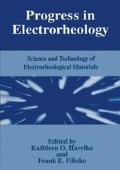Abstract
Applications of the electrorheological (ER) response are limited by a lack of effective fluids. Surfactants may be used to tailor ER suspension properties. We report investigations of the influence of nonionic surfactants on the field-induced dynamic yield stress of various alumina suspensions. We explore the dependence of the yield stress on surfactant type and concentration, particle type, water content, and electric field strength and frequency. Suspension dielectric properties are also investigated. Experimental results at small surfactant concentrations are qualitatively reproduced by a simple model based on Maxwell-Wagner polarization of the disperse phase. This suggests that surfactants act primarily to increase particle conductivity, and hence polarizability, leading ultimately to an increased yield stress. Possible explanations are proposed for deviations from this model at large surfactant concentrations.
Access this chapter
Tax calculation will be finalised at checkout
Purchases are for personal use only
Preview
Unable to display preview. Download preview PDF.
References
W. M. Winslow, Induced fibration of suspensions, J. Appl. Phys., 20:1137 (1949).
Z. P. Shulman, R. G. Gorodkin, E. V. Korobko, and V. K. Gleb, The electrorheological effect and its possible uses, J. Non-Newt. Fluid Mech., 8:29 (1981).
K. D. Weiss and J. D. Carlson, Material aspects of electrorheological systems, J. Intell. Sys. and Struct., 4:13 (1993).
D. L. Hartsock, R. F. Novak, and G. J. Chaundry, ER fluid requirements for automotive devices, J. Rheol., 35:1305 (1991).
Y. F. Deinega and G. V. Vinogradov, Electric fields in the rheological disperse system, Rheol Acta, 23:636 (1984).
H. Block and J. P. Kelly, Electro-rheology, J. Phys. D: Appl. Phys., 21:1661 (1988).
A. P. Gast and C. F. Zukoski, Electrorheological fluids as colloidal suspensions, Adv. Coll. Int. Sci., 30:153 (1989).
T. C. Jordan and M. T. Shaw, Electrorheology, IEEE Trans. Elect. Insul., 24:849 (1989).
G. G. Petrzhik, O. A. Chertkova, and A. A. Trapeznikov, Electrorheological effect in nonaqueous dispersions of various compositions in relation to the electric field parameters, Dokl. Akad. Nauk SSSR, 253:73 (1980).
A. A. Trapeznikov, G. G. Petrzhik, and O. A. Chertkova, Electrorheological properties of nonaqueous dispersions of titanium dioxide and silicone dioxide in relation to concentration and moisture content of filler, Koll. Zhurn., 43:83 (1981).
O. A. Chertkova, G. G. Petrzhik, and A. A. Trapeznikov, Influence of nature of surfactant on the electrorheological effect in nonaqueous dispersions, Koll. Zhurn., 44:83 (1982).
H. Uejima, Dielectric mechanism and rheological properties of electro-fluids, Jay. J. Appl Phys., 11:319 (1972).
N. Sugimoto, Winslow effect in ionic exchange resin dispersion, Bull. JSME, 20:1476 (1977).
D.J. Klingenberg and C.F. Zukoski, Studies on the steady-shear behavior of electrorheological suspensions, Langmuir, 6:15 (1990).
D. J. Klingenberg, Frank van Swol, and C. F. Zukoski, Dynamic simulation of electrorheological suspensions, J. Chem. Phys., 91:7888 (1989).
D. J. Klingenberg, Frank van Swol. and C. F. Zukoski, The small shear rate response of electrorheological suspensions. I. Simulation in the point-dipole limit, J. Chem. Phys., 94:6160 (1991).
D. J. Klingenberg, Frank van Swol. and C. F. Zukoski, The small shear rate response of electrorheological suspensions. II. Extension beyond the point-dipole limit, J. Chem. Phys., 94:6170 (1991).
P. M. Adriani and A. P. Gast, A microscopic model of electrorheology, Phys. Fluids, 31:2757 (1988).
H. A. Pohl, “Dielectrophoresis,” Cambridge University Press, Cambridge (1978).
S. S. Dukhin, Dielectric properties of disperse systems, J. Surf. Coll. Sci., 3:83 (1970).
R. T. Bonnecaze and J. F. Brady, Yield stresses in electrorheological fluids, J. Rheol., 36:73 (1992).
R. J. Hunter, “Foundations of Colloid Science,” Vol. 1, Oxford University Press, Oxford (1989).
Y. D. Kim and D. J. Klingenberg, Surfactant-activated ER suspensions, in: “Electrorheological Fluids,” R. Tao and G. D. Ray, World Scientific Pub., New Jersey (1994).
J. D. Jackson, “Classical Electrodynamics,” 2nd ed., John Wiley and Sons Inc., New York (1975).
M. J. Rosen, “Surfactants and Interfacial Phenomena,” 2nd. ed., Wiley, New York (1989).
B.-Y. Zhu and T. Gu, Surfactant adsorption at solid-liquid interface, Adv. Coll. Int. Sci., 37:1 (1991).
C. C. Nunn, R. S. Schecter, and W. H. Wade, Visual evidence regarding the nature of hemimicelles through surface solubilization of pinacyanal chloride, Langmuir, 1:251 (1985).
C. Brosseau, Electrical conduction in impregnants for all-film power capacitors, J. Appl. Phys., 70(10):5544 (1991).
Z. Randriamala, A. Denat, J. P. Gosse, and B. Gosse, Field-enhanced dissociation, the validity of Onsagar’s theory in surfactant solutions, IEEE Trans. Elect. Insul., 1:167 (1985).
N. Felici, High-field conduction in dielectric liquids revisited, IEEE Trans. Elect. Insul., 1:233 (1985).
D. Atten, J.-N. Foulc and N. Felici, A conduction model of electrorheological effect, in: “Electrorheological Fluids,” R. Tao and G. D. Ray, World Scientific Pub., New Jersey (1994).
Author information
Authors and Affiliations
Editor information
Editors and Affiliations
Rights and permissions
Copyright information
© 1995 Springer Science+Business Media New York
About this chapter
Cite this chapter
Kim, Y.D., Klingenberg, D.J. (1995). Surfactant-Activated Electrorheological Suspensions. In: Havelka, K.O., Filisko, F.E. (eds) Progress in Electrorheology. Springer, Boston, MA. https://doi.org/10.1007/978-1-4899-1036-3_8
Download citation
DOI: https://doi.org/10.1007/978-1-4899-1036-3_8
Publisher Name: Springer, Boston, MA
Print ISBN: 978-1-4899-1038-7
Online ISBN: 978-1-4899-1036-3
eBook Packages: Springer Book Archive

